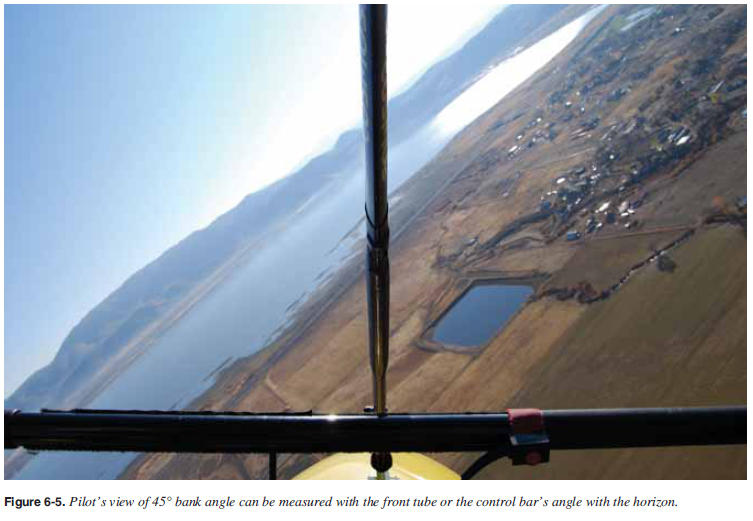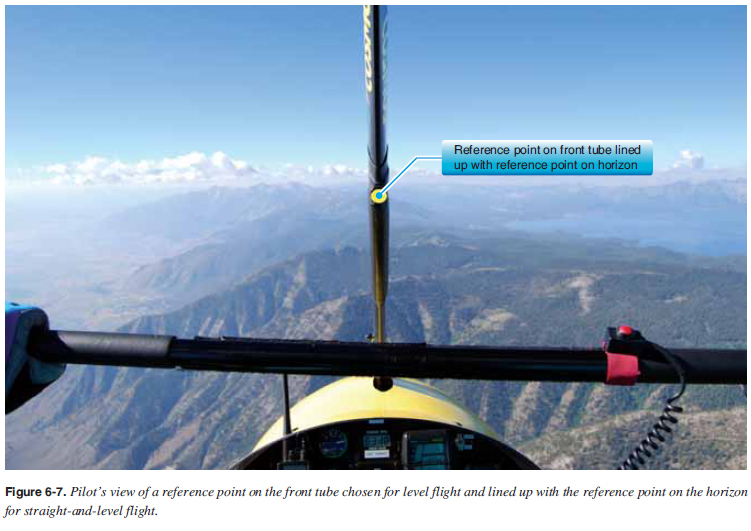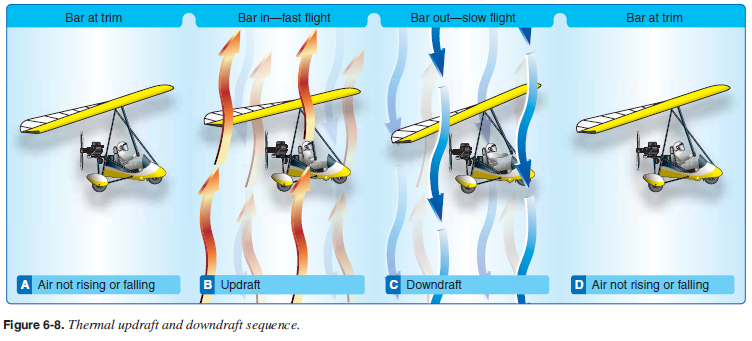
 |
|
||
| CHAPTER 6. Flight Manuevers
Attitude Flying Flying by attitude means visually establishing the aircraft’s attitude with reference to the natural horizon. Attitude is the angular difference measured between an aircraft’s axis and the Earth’s horizon. As discussed in Chapter 2, Aerodynamics, pitch attitude is the angle formed by the longitudinal axis, and bank attitude is the angle formed by the lateral axis. Rotation about the aircraft’s vertical axis (yaw) is termed an attitude relative to the aircraft’s fl ightpath, but not relative to the natural horizon. In attitude fl ying, aircraft control is composed of three components:
 Straight-and-Level Flying Flying straight and level is the most important flight maneuver to master. It is impossible to emphasize too strongly the necessity for forming correct habits in fl ying straight and level. All fl ight is in essence a deviation from this fundamental fl ight maneuver. It is not uncommon to fi nd a pilot whose basic fl ying ability consistently falls just short of minimum expected standards, and upon analyzing the reasons for the shortcomings discover that the cause is the inability to fl y straight and level properly. In learning to control the aircraft in level fl ight, it is important that the control forces be exerted just enough to produce the desired result. Some wings are more responsive than others. The student should learn to associate the apparent movement of the control bar with the response in pitch and roll. In this way, the student can develop the ability to regulate the change desired in the aircraft’s attitude by the amount and direction of forces applied to the controls without the necessity of referring to outside references for each minor correction. Straight-and-level flight is flight in which a constant heading and altitude are maintained. It is accomplished by making immediate and measured corrections for deviations in direction and altitude from unintentional slight turns, descents, and climbs. Level fl ight is a matter of consciously fi xing the relationship of the position of something on the aircraft, used as a reference point with a point on the horizon. In establishing the reference point on the aircraft, place the aircraft in the desired position and select a reference point. A typical reference point on the WSC aircraft is a point on the front tube. The WSC aircraft reference point depends on where the pilot is sitting, the pilot’s height (whether short or tall), and the pilot’s manner of sitting. It is, therefore, important when establishing this relationship, the pilot sit in a normal manner; otherwise the points will not be the same when the normal position is resumed. [Figures 6-6 and 6-7]   Straight-and-level fl ight should fi rst be practiced in calm air where the control movements determine the actual movement through the air and air movement has minimal effect on the aircraft’s altitude and direction. A trim speed needs to be set if the WSC aircraft has an infl ight trim system or the trim speed set on the ground is used. The throttle is adjusted so the aircraft is fl ying level, not climbing or descending. This can be determined by looking at the altimeter or the vertical speed indicator (if so equipped). The throttle setting is the control for maintaining level fl ight for a specifi c weight, loading, trim speed, and density altitude. Level fl ight is maintained by selecting some portion of the aircraft’s nose as a reference point, and then keeping that point in a fi xed position relative to the horizon. Using the principles of attitude fl ying, that position should be crosschecked occasionally against the altimeter to determine whether or not the throttle setting and pitch attitude are correct. If altitude is being gained or lost, the pitch attitude should be readjusted with the throttle in relation to the horizon. Then, recheck the altimeter to determine if altitude is being maintained and adjust the throttle accordingly. The throttle setting for this condition should be noted and all future changes in weight, trim speed, and density altitude referenced to this known throttle setting. After level fl ight is mastered in calm air, it can be practiced in air that is moving, minor turbulence or “active air.” The throttle settings for similar weight, trim, and density altitude are the same, but more pilot input is required to maintain a constant altitude. The throttle is used to maintain a selected distance above the reference point for local air movement, but the pitch pressure (nose up or nose down) is used to control this attitude for shorter duration air disturbances. Typically, updrafts or thermals raise the nose of the aircraft and downdrafts at the edge of thermals lower the nose of the aircraft. For minor updrafts the nose is lowered by pitch control input by the pilot slightly increasing the speed of the aircraft to keep the pitch at a constant level. In moderate to severe updrafts, the throttle can be reduced to assist in maintaining a reasonably constant pitch angle with the horizon. Similarly for minor downdrafts that lower the nose, the nose is raised by pitch control input by the pilot slightly decreasing the speed of the aircraft to keep the pitch at a constant level. An additional caution for raising the nose and decreasing the speed is that raising the nose too high could stall the aircraft. Therefore, caution must be exercised in moderate downdrafts not to reduce the speed too much to approach a stall speed/ critical angle of attack. Similar to reducing the throttle in updrafts to reduce pitch angle, increasing the throttle typically increases the pitch angle. [Figure 6-8]  WSC aircraft can use the front tube as a reference to align perpendicular with the horizon and the wings leveled. It should be noted that any time the wings are banked even slightly, the aircraft will turn. The front tube can be used as an indicator to determine turn rate. If the bar is moving side to side to any established reference point, the aircraft is banked and should be corrected to eliminate any turn. The objective of straight-and-level fl ight is to detect small deviations from level fl ight as soon as they occur, necessitating only small corrections. Straight-and-level fl ight requires almost no application of control pressures if the aircraft is properly trimmed and the air is smooth. For that reason, pilots must not form the habit of constant, unnecessary control movement. Pilots should learn to recognize when corrections are necessary, and then make a measured response easily and naturally. Common errors in the performance of straight-and-level fl ight are:
|
| ©AvStop Online Magazine Contact Us Return To Books |